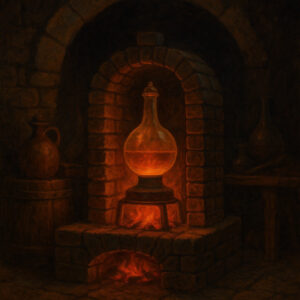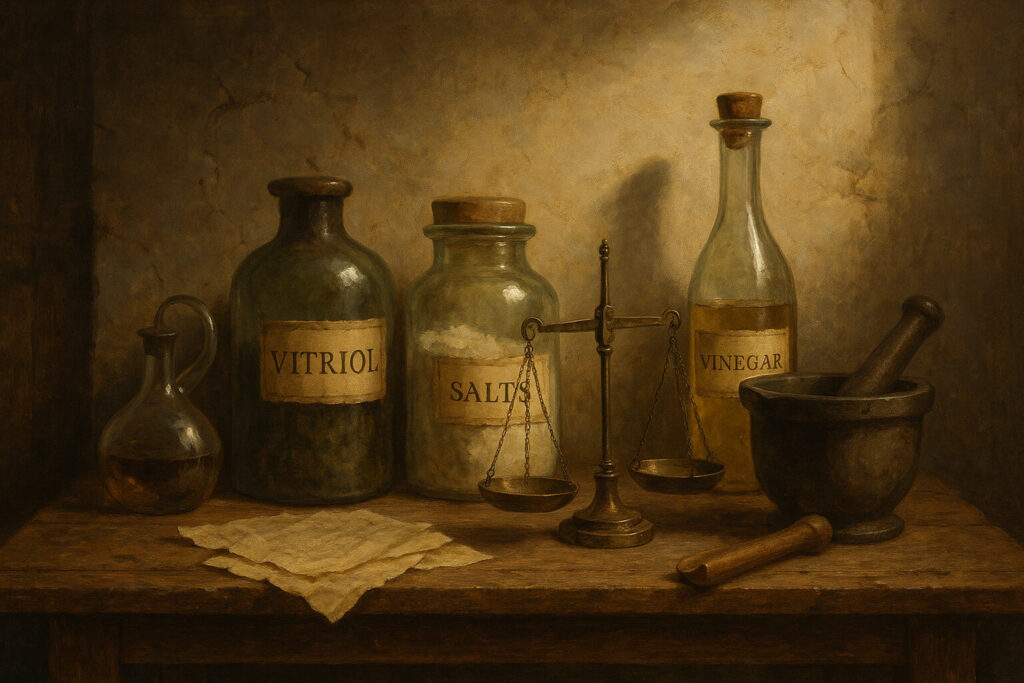Philosopher’s Stone Part Four:
The Summa Perfectionis Magisterii (Pseudo-Geber) — Deciphering the Method

The Summa Perfectionis Magisterii (Pseudo-Geber) — Deciphering the Method
Bibliographic Introduction
The Summa Perfectionis Magisterii—“The Sum of Perfection of the Magistery”—is among the most systematic and influential treatises of medieval alchemy. Attributed in manuscripts and early prints to “Geber,” it was long assumed to be the work of Jābir ibn Ḥayyān, the eighth-century Arabic alchemist. Modern scholarship, however, demonstrates that the Summa is not a translation but a Latin composition from the late thirteenth century, written by an anonymous author now known as “Pseudo-Geber.”
Unlike many alchemical texts, the Summa does not dwell in allegory. It is composed in the style of scholastic disputation, setting out objections and resolutions with clarity. It defines its terms, names its operations, and insists on consistency. This systematic cast is precisely why it became so authoritative: generations of European adepts cited it as the most reliable guide to the magistery.
But our purpose here is not to praise its style. It is to ask: What does Pseudo-Geber actually mean by “philosophical mercury”? What does he instruct us to do with it? And does his method, once deciphered, bring us closer to the philosophers’ stone?
Defining Philosophical Mercury
Throughout the Summa, the author insists that all metals are composed of two principles, sulfur and mercury—not the vulgar substances, but purified and philosophical forms. He writes:
“Every metallic body is composed of sulfur and mercury, not of vulgar sulfur nor of common quicksilver, but of those which are purified and adapted by nature for the generation of metals” (p. 25).
Here “mercury” is not simply quicksilver scooped from a flask. It is quicksilver purified, sublimed, fixed. It is mercury that has undergone repeated operations until it is no longer entirely fugitive. The author stresses that common mercury is “flying” and corrupt; it must be stripped of these qualities to become the true principle.
In practice, this philosophical mercury seems to be purified quicksilver obtained through cycles of sublimation with salts and vitriols. The text speaks often of the need for sublimation:
“Sublimation is the raising of the matter by fire, with adhesion to the vessel, and its purification from feces and superfluities” (p. 63).
What remains after these purgations is not a new substance, but a new condition of mercury: cleansed, clarified, and ready to unite with its mate.
The Work Described
Pseudo-Geber’s operative core can be reconstructed as follows. First, mercury must be purified by sublimation until it is no longer crude and volatile. Sulfur, likewise, must be prepared, freed of its corrosive qualities. Then the two are united. The author states plainly:
“The Elixir is nothing else but the Stone of the philosophers, which is compounded of our mercury and sulfur, joined together and brought to perfection by decoction in a convenient fire” (p. 88).
The whole work is to be conducted in a sealed vessel, under a moderate, continuous heat. This is not the roaring fire of a smith’s forge but the gentle warmth likened by other authors to the heat of a hen brooding her eggs. The process is gradual: the matter blackens in putrefaction, then whitens, then finally reddens. At the red stage, the Stone is perfected, fixed so that it does not flee from fire.
And with this Stone, Pseudo-Geber promises:
“One part of it will tinge a thousand parts of any imperfect metal, changing them into most pure gold; and it will do the same in medicine, restoring health and lengthening life” (p. 91).
This is the complete vision: metallic transmutation, medicinal virtue, and multiplication without loss.
Deciphering the Method
When stripped of scholastic rhetoric, the method of the Summa reduces to a set of clear operations:
-
Select mercury as the primary subject. Not common quicksilver as it stands, but mercury repeatedly purified until it can withstand fire without fleeing.
-
Prepare sulfur as the complementary principle. It must be freed of corrosiveness and rendered subtle. The text is less explicit on this preparation, but implies solution and coagulation with salts.
-
Join the two in a sealed vessel. The Summa insists that the work is unified: one vessel, one fire, one decoction.
-
Maintain a continuous gentle heat. Decoction over time effects putrefaction, whitening, and finally reddening.
-
Fix the volatile. The criterion of success is fixation—mercury held in the fire without flight. When the matter can no longer flee, the Stone is born.
The Summa does not speak in parables here. It names the principles, the operations, and the signs. Its difficulty lies not in riddles but in the ambiguity of “our mercury” and “our sulfur.” These terms conceal the precise composition of the starting materials. Was Pseudo-Geber speaking of actual metallic mercury purified with salts? Of antimonial compounds? Of amalgams with gold? The text leaves this unstated, and herein lies the perpetual problem: clarity of operation, vagueness of matter.
Philosophical Mercury in Context
Compared with Artephius, who insisted on antimony as the key, Pseudo-Geber appears more conservative. His mercury is not the hidden spirit of stibnite but a refined form of the very quicksilver known to every apothecary. His emphasis is on process: purify, sublime, fix. Where Artephius presented antimony as the privileged subject, Pseudo-Geber presents purification itself as the subject. In his vision, any mercury, rightly purified and joined with sulfur, may become the Stone.
This distinction matters. If Artephius represents the antimonial path, Pseudo-Geber represents the mercurial path. Both converge in the doctrine of a perfected ferment, but they disagree on the initial matter. The fact that both insist on a single vessel, a single gentle fire, and the sequence of black, white, red suggests a shared structure beneath the disagreement.
Was Pseudo-Geber a Practitioner?
Signs of laboratory familiarity are abundant. The description of sublimation—matter rising by fire, clinging to the sides of the vessel, freed of feces—rings true to the operator who has actually witnessed the process. The distinction between sublimation and fixation is exact: the one is the volatilization and purification, the other the retention in fire without flight. No compiler of bookish lore would have expressed it with such economy.
And yet, the text is written in the style of a schoolman, with arguments, objections, and resolutions. It systematizes more than it narrates. The probable conclusion is that Pseudo-Geber was both compiler and practitioner. He had handled mercury, seen it sublime, struggled to fix it. But he also gathered doctrines from Arabic predecessors and framed them in scholastic order. His Stone, whether real or theoretical, is the product of both bench and book.
Contribution to the Search
For our project—deciphering the likely methods of the Stone—the Summa Perfectionis contributes a crucial piece. It defines philosophical mercury as mercury purified and fixed through sublimation. It prescribes the union of this mercury with sulfur in a sealed vessel, digested over time to pass through the stages of color. The essence of the method is not the discovery of a new substance but the transformation of known substances by purification and fixation.
If Artephius pressed antimony into the role of mercury, Pseudo-Geber kept mercury itself but insisted on its transformation. Both point to the same operation: the making of the volatile fixed, the rendering of the fugitive stable, the union of contraries in a ferment that does not perish in fire. This is the essence of the Stone.
Conclusion
The Summa Perfectionis Magisterii is less a vision than a method. It does not promise immortality through hyperbole, as Artephius does, but argues soberly that metals are sulfur and mercury, that mercury must be purified, that sulfur must be cleansed, and that their union under a gentle fire yields the Elixir. Whether the author himself possessed the Stone is not knowable. What is knowable is that he gave the West a coherent path: purify mercury, join it with sulfur, and fix it by fire until it becomes red and unconsumable.
If the Emerald Tablet proclaimed the principle, if Zosimos dramatized the workshop, and if Artephius sang of antimony’s hidden spirit, then Pseudo-Geber gave us the first systematic recipe. It is incomplete, but it is structured. It gives us a method to analyze, a definition of philosophical mercury to test against other authors, and a standard of fixation by which to judge the work. In the great library of alchemy, the Summa Perfectionis is the keystone of the arch: holding together vision and practice, symbol and procedure, myth and method.
I was not able to find a free version of this book online, unless you read Latin.
There is an English digital version included in RAM’s Library.
Or, if your prefer, holds it in your hands.
| Author / Text | Philosophical Mercury | Preparation Steps | Union Method | Fire / Heat | Color Signs | Product Claims |
|---|---|---|---|---|---|---|
| Zosimos of Panopolis (c. 300 CE) | “Divine water” in the kerotakis; volatile spirit ascending and descending | Calcination, sublimation, distillation, washing | Circulation in sealed vessel; dissolution and recombination | Gentle, regulated heating; moist fire | Blackening, whitening, reddening | Tincture, purification of metals; spiritual rebirth |
| Emerald Tablet (Arabic/Latin, 9th–12th c.) | “One Thing” mediating heaven and earth; volatile principle implied | None explicit; “separate the subtle from the gross” | Circulation: ascent and descent of the subtle | Not named; implied gentle force | None specified; allegorical “glory of the whole” | Perfection of all things; universal power |
| Turba Philosophorum (12th c., Arabic → Latin) | Permanent water: vinegar/gum/spume of Luna; volatile-fixative solvent | Putrefaction 40 days; washing; imbibition; coagulation | Copper (sometimes with lead/tin) dissolved in permanent water | Gentle fire; sealed vessel; staged regimen | Blackening → Whitening → Reddening → Tyrian purple | Tincture of metals; Stone “not a stone”; invariable color |
| Artephius, Secret Book (12th c.) | Hidden mercury within antimony; combined with gold | Dissolution of Sol/Luna in “living water” (moist fire); putrefaction | Antimony + mercury + gold in one vessel | Gentle, continuous heat (“hen brooding eggs”) | Black → White → Red | Incombustible oil; multiplicative tincture; longevity |
| Pseudo-Geber, Summa Perfectionis (13th c.) | Purified, sublimed, partly fixed quicksilver | Repeated sublimation with salts/vitriols; fixation of volatile | Mercury + purified sulfur joined in vessel | “Convenient fire”: moderate, continuous decoction | Black → White → Red | Philosophers’ Stone (Elixir); projection of metals; medicinal virtues |
Dr. Justin Sledge of Esoterica is always enlightening and has some excellent commentary on Summa Perfectionis:


